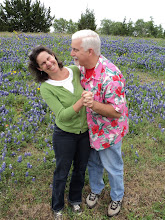Happy Thanksgiving! On any list of the things for which we give thanks, the Austin Farmers Market (downtown on Saturday mornings and at the Triangle on Wednesday afternoons), the Sunset Valley Farmers Market (on Saturday mornings), and Boggy Creek Farm (on Wednesday mornings) rank at or near the top. They’ve become a huge part of our lives, and our consumption of weird seasonal vegetables has skyrocketed, which I personally think is pretty cool, though our last remaining teenager might beg to differ.
Moreover, Heather says, with only mild exaggeration, that she’d have no social life at all if not for the farmers markets, and our Saturdays feel incomplete if we haven’t seen Sonny Fitzsimons of Thunder Heart Bison, Jesse Griffiths of Dai Due (that’s him in the photo above), J. P. Hayes of Sgt. Pepper’s, Loncito Cartwright of Loncito’s Lamb, and the rest of the gang at their stalls. Heck, they’re nice to us even when we don’t buy anything from them!
All kidding aside, the social aspect of farmers markets is actually one of the most important things about them. But don’t take my word for it; listen to Richard McCarthy and Daphne Derven, the executive directors of two organizations that have played crucial roles in the (re)birth of farmers markets in New Orleans, thereby helping the Crescent City bounce back in the aftermath of Hurricane Katrina.
According to McCarthy, executive director of MarketUmbrella.org, reinventing older traditions like the farmers market has helped New Orleans bridge long-standing divisions of race, class, and region as it seeks to recover in the wake of Hurricane Katrina. The storm, as terrible as it was, has afforded the city a rare opportunity to rethink, not simply recreate, its civic and social institutions: “As we rebuild, all the old issues have been laid bare. Now we have the chance to address them.”
McCarthy said that many farmers and fishermen from outside New Orleans were initially terrified by the prospect of coming into the city to sell their crops and catch, but in the Big Easy, where cuisine is the nearest thing to a civic religion, talking about and looking at food brought people out of their homes and into previously scary public spaces. The city’s markets served a vital function for people who were grieving the devastating loss of family, friends, and property; as McCarthy put it, “They wanted the public place where they could hug each other, cry, see the citrus and the flowers.”
He noted that some have marginalized the local/sustainable food movement, in part because “we defined what we were against, rather than what we were for.” Instead, he advocates portraying markets as the legitimate community assets they are; as an example, he cited the Crescent City Farmers Market, which contributed $8.9 million to the local economy last year.
Despite such impressive numbers, access to food remains a major issue in the city, according to Derven, executive director of New Orleans Food and Farm Network. In New Orleans East, for example, there is only one supermarket for a population of 28,000 people (the national average is one supermarket for every 9,000 people). She added that there are around 60,000 empty properties in New Orleans, more than three times the pre-Katrina total. Her organization aims to educate and empower individuals, neighborhoods, and communities, “from the person growing herbs in a pot to urban farmers cultivating up to fifty acres,” to use the available land to grow food. She believes that “‘Farmer’ is the green job of the next decade.”
We heard McCarthy and Derven at the nineteenth annual conference of the Alliance of Artists Communities, held in New Orleans on November 11–14. They were panelists at a fascinating session convened by New Orleans columnist, filmmaker, and food maven Lolis Eric Elie, which also featured Donna Cavato, director of the wonderful Edible Schoolyard New Orleans program at the S. J. Green School, and Rashida Ferdinand, director of the Sankofa Marketplace in the Lower Ninth Ward. The theme of this year’s conference was “Sustaining Today’s Artists,” and what better place to think about how to support the creative imagination than the Crescent City, which is once again a vibrant cultural center despite the devastating (and ongoing) effects of Katrina?
The conference was an epic win. We learned a lot, we met many smart and fascinating people, and of course we ate like royalty (high points: the “best roast beef po’ boy on earth,” as proclaimed by Gourmet Magazine, at Parasol’s; the fried okra, crawfish etouffée, and bread pudding at The Praline Connection; and the Louisiana shrimp and grits at Herbsaint). But the best and most inspiring food of all was the food for thought prepared and served by McCarthy and Derven and their fellow panelists.
—Martin
What we’re reading
Heather: Denise Levertov, Selected Poems
Martin: Douglas Brinkley, The Wilderness Warrior: Theodore Roosevelt and the Crusade for America (still!)



No comments:
Post a Comment